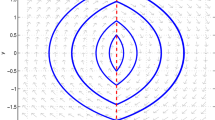Abstract
We consider the second-order discontinuous differential equation y″ + η sgn(y) = 𝜃y + α sin(βt) where the parameters η, 𝜃, α, and β are real. The main goal is to discuss the existence of periodic solutions. Under explicit conditions, the number of such solutions is given. Furthermore, for each of these periodic solutions, an explicit formula is provided.










Similar content being viewed by others
References
Andronov AA, Vitt AA, Khaikin SE. Theory of Oscillators. New York: Dover; 1996.
Cid JA, Sanchez L. Periodic solutions for second order differential equations with discontinuous restoring forces. J Math Anal Appl 2003;288:349–364.
Jacquemard A, Teixeira MA. On singularities of discontinuous vector fields. Bull Sci Math 2003;127:611–633.
Jacquemard A, Tonon DJ. Coupled systems of non-smooth differential equations. Bull Sci Math 2012;136(3):239–255.
Kunze M, Küpper T., You J. On the application of KAM theory to discontinuous dynamical systems. J. Differential Equations 1997;139:1–21.
Jacquemard A, Teixeira MA. Periodic solutions of a class of non-autonomous second order differential equations with discontinuous right-hand side. Phys D 2012;241: 2003–2009.
Chen H, Duan J. 2018. Bounded and unbounded solutions of a discontinuous oscillator at resonance. International Journal of Non-Linear Mechanics. https://doi.org/10.1016/j.ijnonlinmec.2018.06.003.
Lazer AC, Leach DE. Bounded pertubations of forced harmonic oscillators at resonance. Ann Mat Pura Appl 1969;41:49–68.
Author information
Authors and Affiliations
Corresponding author
Additional information
Publisher’s Note
Springer Nature remains neutral with regard to jurisdictional claims in published maps and institutional affiliations.
The first author was supported by Coordination of Superior Level Staff Improvement (CAPES), process number 99999.005335/2014-00. The second author is supported by the Brazilian-French Network in Mathematics: National Council for Scientific and Technological Development (CNPq) and National Center for Scientific Research (CNRS). The third author is supported by Grant 301275/2017-3, National Council for Scientific and Technological Development (CNPq)
Appendix
Appendix
Consider Eq. (1) with β = 1, η = −𝜃 = 1/25 > 0:
From Lemmas 6.1 and 6.2, the solution satisfying
with \(k\in {\mathbb {N}}\setminus \{0\}\), is
By Lemma 6.4, the condition η ⋅ tan (kπ/10) > 0 is satisfied only when tan (kπ/10) > 0. This gives us the restriction on k ∈{1, 2, 3, 4}. For each k, there is a positive number \(\alpha ^{*}_{k}=\min \{K_{1}^{(k)},K_{2}^{(k)},K_{3}^{\theta ,(k)}\}\). We will denote \(\alpha ^{*}=\min \{\alpha _{i}^{*}\hspace {0.15cm} | \hspace {0.15cm} i = 1,2,3,4\}\). Some calculations give us \(\alpha ^{*}=K_{3}^{\theta ,(1)}\cong 0.048537\). For |α| < α∗, we have the following configurations for the solution on [0, kπ], with k = 1, 2, 3, 4 and k = 6, 7, 8, 9 (Fig. 11).
Observe that for k = 6, 7, 8, 9, the solution is such that y′(0) < 0 and the necessary conditions of Lemma 6.3 are not met. For k = 1, there is a value α for which we obtain a simple singular 2π–periodic solution. This value is given by the condition x(π/2) = 0 and is α = (24/25)(sec(π/10) − 1). See Fig. 12.
Now, if we consider η = 𝜃 = − 1/25 < 0, the solution satisfying the initial conditions
with \(k\in {\mathbb {N}}\setminus \{0\}\), is
By Lemma 6.4, the condition η ⋅ tan (kπ/10) > 0 is satisfied only when tan (kπ/10) < 0. This gives us the restriction on k ∈{6, 7, 8, 9}. For each k, there is a positive number \(\alpha ^{*}_{k}=\min \{K_{1}^{(k)},K_{2}^{(k)},K_{3}^{\theta ,(k)}\}\). We will denote \(\alpha ^{*}=\min \{\alpha _{i}^{*}\hspace {0.15cm} | \hspace {0.15cm} i = 6,7,8,9\}\). Some calculations give us \(\alpha ^{*}=K_{3}^{\theta ,(1)}\cong 0.048537\). For |α| < α∗, we have the following configurations for the solution on [0, kπ], with k = 6, 7, 8, 9 and k = 1, 2, 3, 4:
Observe that for k = 1, 2, 3, 4, the solution is such that y′(0) < 0 and the necessary conditions of Lemma 6.3 are not met (Fig. 13).
Rights and permissions
About this article
Cite this article
da Silva, C.E.L., Jacquemard, A. & Teixeira, M.A. Periodic Solutions of a Class of Non-autonomous Discontinuous Second-Order Differential Equations. J Dyn Control Syst 26, 17–44 (2020). https://doi.org/10.1007/s10883-018-9426-7
Received:
Published:
Issue Date:
DOI: https://doi.org/10.1007/s10883-018-9426-7






